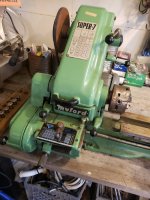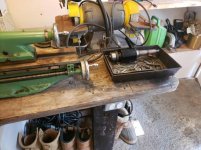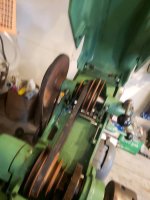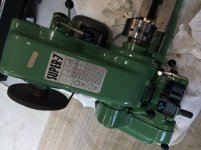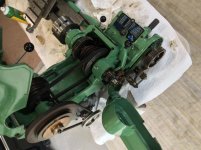Jim, I'm no sniper. Just a fellow looking for expert help. I didn't realize this was a hoity-toity type machinist forum, my bad. When searching on posts relevant to my inquiry, this forum came up a lot, perhaps more than HSM, so I assumed that class of lathe was in its wheelhouse. Thank you forum gods for not erasing the thread, its been quite useful for me. Anyway, with all you 'ol timer
omnipotents dying off, you're going to need some young blood in here to keep this trade alive. We have metal 3d printing now you know.
Anywhoo, I did go to look at the Schaublin and had to have a long, hard think about it. As I slept on it, I had your comments ringing in my ear, but in the end, although it was in excellent shape, VFD and maintained by a toolmaker, I know I'd miss the gadgets and power feed too much. Its integral to what I do. I did look for other lathes, and was tempted by an EMCO, but couldn't find a SB9. I think those would have been a great for me too.
Welp, I went and bought the Myford today. I probably paid too much, but the seller delivered it to my shop, and it came with a couple boxes of goodies. Of notable interest are a bunch of new milling tooling and a MT4-sized Tappmatic (anyone want to trade for a little MT2?). There was another chuck based thing in the box I cant identify, maybe I can take a pic for you guys so you can tell me what the hell it is?!
An uninformed prior owner used grease instead of Hydraulic oil (any recommendations?) in the fittings everywhere, so a breakdown is required. I only fired it up for a second to see if the POS 1/2hp motor worked, but didn't want any more wear on that pricey bronze bushing. I was pleasantly surprised to learn as I started breaking it down that this lathe is near new; it probably has less use than my current lathe. It has some paint chipping around, and the exposed metal bits are a little discolored here and there, but not pitted. Overall its in pretty good cosmetic shape - she's a
6 footer.
I spent most of the day cleaning cosmoline off all the undergarments of the old girl (c.1982). There was so much on the tool post slide, it was locked up solid. The lead screw and slides show no sign of wear, and still have the original scraping. I am AMAZED at the near zero resistance and total lack of play in the cross slide, and I mean.. ZERO play when grabbing the QCTP and rocking it hard in all directions. There is also near zero backlash everywhere - far less than the Schaublin and a friend's SB10 I played with recently. This is a really, really nice machine so far, and oh, it has power crossfeed, clutch, quick change gearbox, backgear, and is metric to boot.

I know this doesn't impress most of you, but at the moment, it was the best option for me, and I'm stoked. If I hadn't jumped on it, I'm sure it would have sold this week and I would have spent the next 6 months tirelessly watching CL and FB for something to pop up. And you can bet it wouldn't be another Myford in this shape. I think I would have ultimately preferred a SB9 to keep it American, but the Myford Super 7 is a pretty machine, and its not chinese.
Thanks very much for
(almost) everyone's help.
My new adventure will be converting it to a VFD with a new motor. If anyone has an opinion on components, I'd love to hear it. This is what I know I need so far (maybe this should be a new thread, and maybe not on this forum.. but f-it, I have your attention)

:
In order of importance:
- B56 frame base mount, TEFC housing, 3phase, 1hp, 1800 RPM motor (Baldor?! TECO? Hitachi?)
- As QUIET as possible (motor and VFD. I have good high frequency hearing, so I'm trying to avoid as much ringing as possible).
- 120v supply (unfortunately, no easy access to 240V and I'm too lazy to bust up walls to run a line)
- VFD with a reversing momentary switch feature (This will give me the quick reversing feature I wanted. The Myford chuck is screw on, so I have to be careful and make sure it ramps from F to R)
- VFD remote display capability
- $500-1000 budget (for motor and VFD)
I'm leaning heavy towards a Baldor (#EM3546 maybe?!
EM3546 - Baldor.com ), but I'm clueless on the VFD.. opinions?



 :
: Lots of good info there in the link, sounds like you did really well buying it.
Lots of good info there in the link, sounds like you did really well buying it. But like you say there is very good information to be had if you can hold your temper and sift through the bull****. Bite your tongue, smile and nod... you know the routine.
But like you say there is very good information to be had if you can hold your temper and sift through the bull****. Bite your tongue, smile and nod... you know the routine.